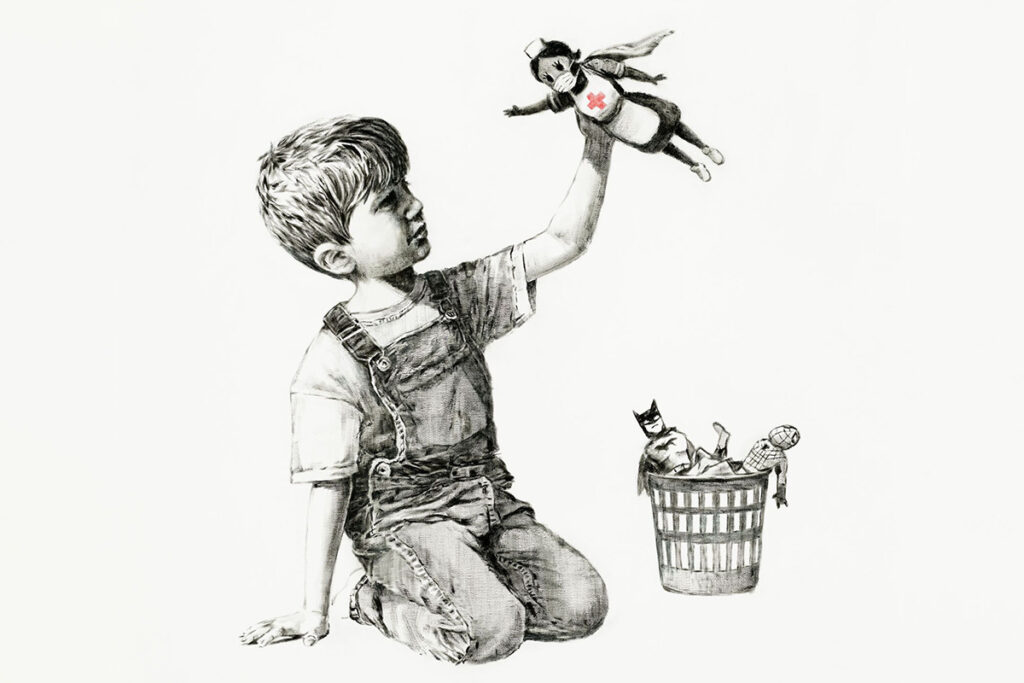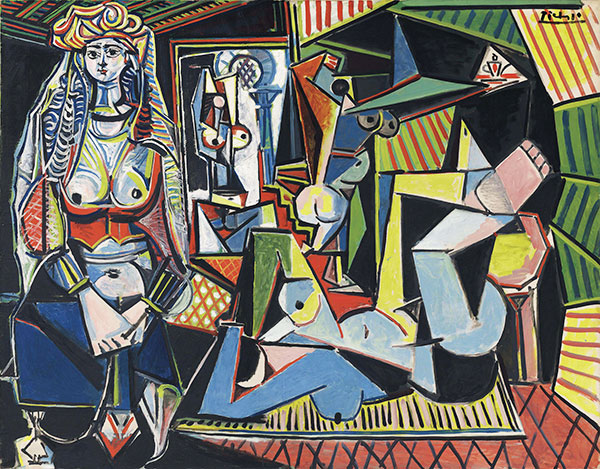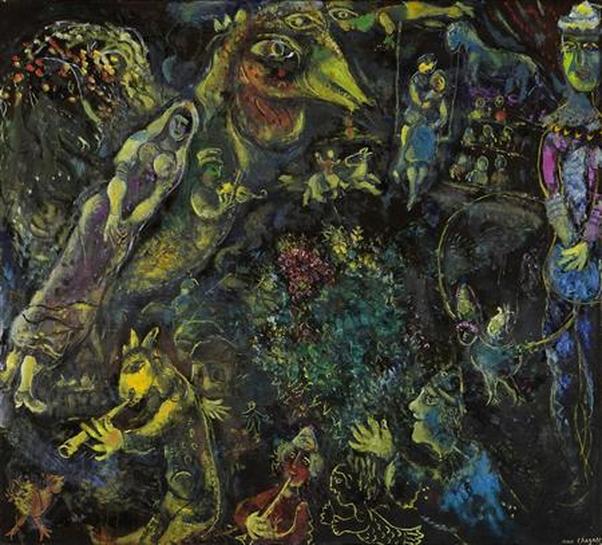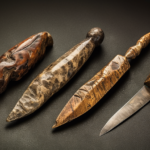The irony is not lost on Nina Fay Tennyson that her initials are now synonymous with the fastest growing niche industry, and latest internet trend, on the planet right now. An educator by trade, South Carolina resident Nina will tell you that while she’s not quite sure whether her family hails from the great English poet Alfred Tennyson, she knows that she’s always been able to turn a phrase and bust a rhyme. “In English Lit they used to say I was cheating. Because of my name.” At a diminutive five foot three, the sunny dispositioned Tennyson seems to stand taller than her actual height, even while wearing flip-flops on grass. Nina is fifty-four and announces to us that she will turn fifty-five in June. “This year for my birthday I finally get to go to the Bahamas.”

Most Expensive Painting Sold: Banksy’s “Love is in the Bin” is now Banksy’s most expensive work, selling for US$25.4 million in an auction in London. This makes it his most expensive artwork. This piece of art had beat out his previous painting “Game Changer” which sold for US$23 million.
Nina’s new financial status as an artist whose work has been discovered puts the Caribbean vacation at the top of her achievable bucket list. The Bahamas trip is decades in the making and comes on the heels of a time when the pandemic of the last two years has made international travel either a supreme hassle or a dream deferred. During those twenty-four months of lockdowns and self-quarantines that Covid-19 fears imposed on schools as well as restaurants, hair salons and other public spaces, Nina Tennyson mostly stayed home and developed a latent talent: painting.
“When the pandemic got to the point where even bus drivers were getting sneezed on and dying in a matter of weeks, I knew I had to go inside.” Going inside is Nina-speak for taking her career in education on the road. The Special Education teacher says she had to make a difficult decision to no longer put herself in harm’s way vis-a-vis teaching in person in a classroom setting where students, faculty and parents alike could be the trojan horse that just might bring Covid knocking. As the sole caregiver for her elderly mother, Nina knew it was incumbent upon her to hold to a strict protocol beyond masks in public, latex gloves in the supermarket, and scrubbing the groceries before putting the away. She went into what she calls “an early retirement,” but says that mounting bills and a thirst to interact with students again made her decide to look into the field of online teaching. Tennyson thought that if she could make the adjustment from the front of the classroom to the front of a ZOOM call, she could still do what she’d always loved: help kids learn. But the task was daunting.

Most Expensive Painting Sold: This past Monday, Picasso’s “Women of Algiers (Version O)” sold at auction in New York for $179,365,000. The painting is considered to be one of the Pablo Picasso’s most important works.
“Teaching online is nothing like teaching in the classroom,” Tennyson says. Her first attempts to get hired by the likes of Japan-based VIP Kid and USA-based Stride, formerly K12.com, were an epic fail. VIP Kid trains and hires ESL instructors to teach Japanese students how to speak and read English. Stride is based in the United States and hires certificated teachers to deliver the public-school curriculum to grades Kindergarten through twelfth via online instruction. Both are live and in real time, requiring a different set of teaching skills than most teachers in traditional school possess.
“I kept having to try to stop myself from doing what I had learned as a teacher in a normal setting. With VIP Kid I kept failing the demos. And the K12 hiring process is…” She shakes her head to indicate a sort of befuddlement with the way the nation’s largest online public school chooses its teaching staff. When an internet search led her to a company called Varsity Tutors, Tennyson was a shoo-in for the application process. With her years of experience and the growing need for online tutors, the company which boasted flexibility and creative freedom seemed like a perfect fit. That is until she reached the part about recording a short clip of her actually teaching a course. Making peace with the camera without benefit of Instagram filters made Tennyson self-conscious and she came to the conclusion that if she was going to be teaching anything on camera, it should be something she absolutely loved and resonated with so that she could totally relax and just be herself for her students.
“I started painting.”
Tennyson describes how she set up a canvas on an easel and placed it in front of her iphone, which she mounted to a tripod. “Simple and cheap. I got a tripod from Amazon.com and I’ve had my iphone forever. I was still using the six. There was nothing wrong with it.” And so began her career as a painter of alphabet characters. “One thing I saw with every online teacher. They needed their own props. I looked around in the dollar stores for things that would pop. Colors and textures and shapes. All the things my kids used to love.” Nina ended up painting her own series of alphabet characters that she designed on a sketch pad and created on camera to be edited into her recorded teaching sessions on phonetic awareness. It took off like hotcakes.

Most Expensive Painting Sold: An artwork by Modernist master Marc Chagall became the most expensive contemporary Western painting sold in Asia when it was auctioned for $4.18 million after steady bidding in a Hong Kong sale. Source Reuters.
To date her letters have fetched a whopping 1.2 million dollars. “I turn them into NFT’s,” the newly-minted millionaire laughs with a Eureka moment flip of her paintbrush. She explains how one of her students’ parents was in the Non-fungible tokens business and immediately pounced on the opportunity to collab with her after being called to the screen by his kindergartener at the introduction of every exquisitely designed and painted letter Miss Tennyson made.
Most Expensive Painting Sold: NFTs
For those who ask, from whence came this strange beast, this non-fungible token of which you speak? The non-fungible token racket only reached “racket” status in 2021 when this splinter cell of pop culture technology exploded onto the mainstream on the coattails of crypto. Tied in with all things future chic, NFT, which has been around since 2014, took its place among the hip new terminology of the twenty-first century, right up there with Bitcoin, blockchain, and the ubiquitous “metaverse”. But for many, a little vocabulary lesson would be in order.
“Fungible”, which has nothing to do with the Afro-Caribbean cornmeal dish, fungie, nor with the much-reviled messenger of decay, fungi, describes an asset that can be replicated. Think good old-fashioned money. Ones and fives, twenties and tens, hundreds and so on. When something is Non-fungible, however, it is unique and cannot be traded or exchanged at equivalency, and there lies the NFT, differentiating it from its blockchain brethren, cryptocurrency: Bitcoin, Ethereum, Dogecoin, and the like. Blockchain, where the tokens are sold, is trickier to define except to the very techno elite, but suffice it to say, NFTs go with blockchain like choo-choo trains go with tracks. Together the treacherous three, Crypto, Blockchain and Non-fungible Tokens are tearing through online culture, making millionaires out of some, like Nina Tennyson, and fools of others.
How so fools? Consider the fact that something considered so valuable, unique and thus, rare, can essentially be lifted right off the screen via right click, copy and save, and one wonders where the rarity lies. But that’s for the techno art elite to figure out. Right now, the trend continues to evolve at a rip-roaring pace that necessitates YouTube tutorials on how to acquire a crypto wallet, how much it costs to “mint”, which market is best to list on: OpenSea or Rarible…, and can anyone really trust Coinbase anymore, if ever one could?
In a world where something is only as valuable as everyone else can be convinced it is, the NFT has found its Shangri-la, one the Most Expensive Painting Sold. Among the super-rich — and more than slightly bored — art has always been a favored item to boast of, collect, covet, and, yes, steal. Arguably, NFTs have done for the twenty-first century artworld what the Renaissance did for the fifteenth century: given subjective visual expression permission to be here. But in this case, the “here” is neither “here” nor “there”, which brings us to that sticky wicked netherland, the metaverse.
NFT’s main value may only be realized in the place that dare not speak its name: Mark Zuckerber’s I-own-it-no-you-don’t-because-I-own-it Metaverse. Posturing, posing and posting with a well-appointed digital image that, in some weirdly understood and inexplicably agreed to way – only you and people cool and rich like you own, goes over best over there. Here on this side, many of the most-lauded pieces don’t hold a candle to the likes of the Funny Papers comic strips characters of old. With Crypto-Punk and other Collections being an especially hot item, Nina Tennyson’s alphabet series is right on the money in more ways than prescribed. Nina’s work goes both ways. Digitalize it and you’ve got your bitchin’ NFT. Publish the original sketches and finished artform that gave birth to the digital rendition, and you’ve got an Art Basel moment waiting to happen.
Art Basel is the Comic Con of the art world and has been around since 1970 but its hip and happening Miami Beach scene has blossomed into a celebrity summer glamp where the likes of Kardashians, Jenners, and the Coco Chanel crowd go to buy, sell, see and be seen buying and selling art while sipping from fluted glasses. Can the metaverse do for the often cartoonish, graphic artist-heavy world of digital visual expression what an Art Basel does for gallery society? Can it engender culture and effuse meaning even as it awards its artists their shining moment in the celebrity sun? If it does, it will truly be a rebirthing of art and its appreciation, and already seems to have the potential to do so. Never before have seemingly so many young celebrities gotten so vigorously and swiftly behind an art form as NFTs has inspired them to do. From tennis champion Naomi Osaka’s tangential decision to go into the NFT design business in lieu of continuing to play competitively, to Paris Hilton’s showing up on late night television to put star power behind some really lucky dude’s underwhelming design, art and its appreciation are getting a kiss of life. And so is attention to the artist as a societal MVP.
Original works of art get a new lease on life when digitized and made into a non-fungible item. Listing her pieces on the Ethereum blockchain, Nina gets to see her alphabet collection thrive in multiple worlds. One, on every live-streamed class she teaches, where her students get to see her breathe life into each piece, right before their eyes; Two, in the metaverse where art and crypto are traded and flung across the blockchain like trapeze artists who meet for a brief moment in the center of the circus ceiling, high above the mortal crowds; and three, in the galleries of places like Miami and Lake Tahoe, where the headlines proclaim, “Most Expensive Painting Sold…” for a cool million by a five-foot three retired school teacher who paints the letters of the alphabet simply for the love of it.
Meanwhile, back at the arts and crafts table, moms and mentors are hovering over their preschoolers’ every macaroni masterpiece, wondering if this will be the one to catapult little Johnny into the Modern Museum of Art. Don’t laugh. In the hands of a forty-dollar digitizer, white puffy clouds made of cotton balls, and torn scraps of construction paper applied just so can become tomorrow’s coveted item on the blockchain, taking its place among the Bored Ape Yacht Club non-fungible collection which recently netted $2.8 million. Who knows, one mother of a twelve-year-old homeschooled sixth grader shrugs. She’d been trying to get her daughter off the computer all year but backed off when the child explained to her that she was earning “200 Robux” per piece sold, creating avatars for players out of characters produced in her own mind.
All of that, notwithstanding, there is a decided upside to the breath of new life that the world of artistic expression has recently received. Over the last two decades, with Science, Technology, Engineering and Math holding sway over the academic world for seeming to enrich the lives of students with more relevant study endeavors than the stalwarts of a liberal arts education, art was all but being threatened with extinction. “I can remember getting a question on my Praxis exam where I had to write an essay asking me what I would cut from the budget if I were in the position to make such decisions in schools.” Tennyson is thoughtfully somber as she recalls her answer to the question that she hastily and passionately scribbled before the timer rang, ending her exam. “This was in 2011 or so…” She sighs and shrugs guiltily. “It was art.”
Do you want to appraise art? Let’s try our online service.





OTS List. One of the largest Open Tibia server bases from around the world. The list was created to make it easier for the owners of OTS to advertise, and thus to win players. Adding a server is completely free, and it brings the expected results – an increase in the number of online players. The website has a very friendly search engine, thanks to which you will find a server for yourself.